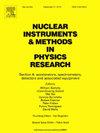Global crystal identification of light-sharing PET detectors using convolutional neural networks
IF 1.5
3区 物理与天体物理
Q3 INSTRUMENTS & INSTRUMENTATION
Nuclear Instruments & Methods in Physics Research Section A-accelerators Spectrometers Detectors and Associated Equipment
Pub Date : 2025-04-23
DOI:10.1016/j.nima.2025.170564
引用次数: 0
Abstract
In light-sharing positron emission tomography (PET) detectors, Anger logic enables identification of crystals smaller than the photodetector size. This approach, which employs a 2D position histogram and pixel-to-crystal mapping, is widely adopted due to its hardware implementation simplicity. In contrast, independent readout systems allow interaction detection using light distribution analysis via photodetector arrays, as each photodetector collects signals independently. Both approaches require detector-specific recalibration during manufacturing, maintenance, and replacement. In this work, we develop a PET scanner-wide crystal identifier using convolutional neural networks (CNNs). Using independent photodetector signals obtained experimentally, the CNN processes crystal addresses derived via Anger logic as training data. When applied to a small animal PET scanner with 126 light-sharing PET detectors, the model is trained using 5 million events from only 40 detectors after denoising, which particularly includes removal of inter-crystal scattering (ICS). By learning light distribution, the CNN also operates as an ICS identifier that sets thresholds to suppress ICS events. With 98 % accuracy in photoelectric absorption events, we confirm a small rod phantom, validated to have similar timing and imaging performance as for Anger logic, provides a 1.7-fold improvement in sensitivity. This CNN-based crystal identifier eliminates the need for recalibration while maintaining image quality and offering applications in maintenance, replacement, and mass production.
基于卷积神经网络的共光PET探测器全局晶体识别
在共享光正电子发射断层扫描(PET)探测器中,Anger逻辑可以识别比光电探测器尺寸更小的晶体。该方法采用二维位置直方图和像素到晶体的映射,由于其硬件实现简单而被广泛采用。相比之下,独立读出系统允许通过光电探测器阵列使用光分布分析进行交互检测,因为每个光电探测器独立收集信号。这两种方法都需要在制造、维护和更换期间对探测器进行特定的重新校准。在这项工作中,我们使用卷积神经网络(cnn)开发了PET扫描仪范围的晶体标识符。利用实验获得的独立光电探测器信号,CNN处理通过Anger逻辑得到的晶体地址作为训练数据。当应用于具有126个共享光PET探测器的小型动物PET扫描仪时,该模型在去噪后仅使用来自40个探测器的500万个事件进行训练,其中特别包括去除晶体间散射(ICS)。通过学习光分布,CNN还可以作为ICS标识符,设置阈值来抑制ICS事件。在光电吸收事件中,我们确认了一种小型棒模体,经验证具有与Anger逻辑相似的时序和成像性能,灵敏度提高了1.7倍。这种基于cnn的晶体识别器消除了重新校准的需要,同时保持图像质量,并提供维护,更换和批量生产的应用。
本文章由计算机程序翻译,如有差异,请以英文原文为准。
求助全文
约1分钟内获得全文
求助全文
来源期刊
CiteScore
3.20
自引率
21.40%
发文量
787
审稿时长
1 months
期刊介绍:
Section A of Nuclear Instruments and Methods in Physics Research publishes papers on design, manufacturing and performance of scientific instruments with an emphasis on large scale facilities. This includes the development of particle accelerators, ion sources, beam transport systems and target arrangements as well as the use of secondary phenomena such as synchrotron radiation and free electron lasers. It also includes all types of instrumentation for the detection and spectrometry of radiations from high energy processes and nuclear decays, as well as instrumentation for experiments at nuclear reactors. Specialized electronics for nuclear and other types of spectrometry as well as computerization of measurements and control systems in this area also find their place in the A section.
Theoretical as well as experimental papers are accepted.

 求助内容:
求助内容: 应助结果提醒方式:
应助结果提醒方式:


